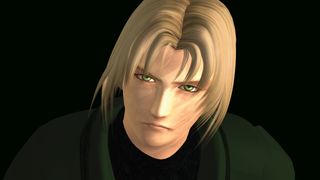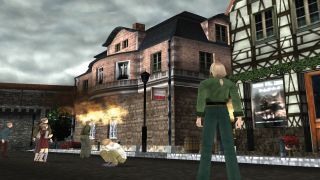Revisiting Konami's forgotten time travel adventure, Shadow of Memories
Can you save the life of this astonishingly dull man?


Reinstall invites you to join us in revisiting PC gaming days gone by. Today Andy digs a quirky time-travel puzzler out of the archives.
Eike Kusch leaves a restaurant in the fictional German town of Lebensbaum. As he walks down a cobbled side street, he has the uneasy feeling that someone is following him. Then, in a flash, an unseen figure stabs him in the back and he slumps to the ground, dead. Game over. Or is it?
Kusch wakes up in a strange, otherworldly void. A grandfather clock ticks loudly as he picks himself off the floor, then an odd being calling itself Homunculus appears before him. In an eerily calm, slightly sinister voice it says it’s giving him a second chance at life. It hands him a device called a Digipad, which Kusch learns he can use to travel back in time and prevent his own death. He activates it and finds himself back in Lebensbaum hours before he died, and sets about thwarting his mysterious murderer’s plans.
Shadow of Memories—or Shadow of Destiny as it’s known in some regions—was released for PC in 2003, and it’s a deeply weird game. Set entirely in Lebensbaum across a variety of time periods, from the 1500s to the present day, it’s a game about carelessly meddling with the space-time continuum to save the life one man, with no regard for the ensuing chronological fallout. Kusch dies horribly at the beginning of each chapter, and foiling the killer involves leaping through time and seriously disrespecting the temporal prime directive in order to stop him.
It is possible to completely screw things up, though. In the first chapter, if you return to the restaurant, you’ll find yourself sleeping on the table. And if you interact with your other self, Kusch will idiotically wake himself up, cause a time paradox, and obliterate himself from existence. There are other examples of this, and I like how the game almost encourages you to try to break time by seeing how far you can push things. Unfortunately, even though it’s a semi-open world, the game is stiflingly linear, and you never get the sense that you can really experiment with the Digipad.

In one chapter the killer ambushes Kusch from behind a tree in the town square. So what does Kusch do? He travels back to medieval times, of course. After scaring some bewildered peasants by waving his mobile phone around and making it ring at them, he finds the guy planting the tree and convinces him to plant some flowers instead. Then the Digipad lights up, indicating that you’ve done enough to foil the killer, and can safely return to the present. Sure enough, when you arrive the tree has been replaced by a flower bed, and Kusch lives another day. Or, alternatively, you can ask the guy to build a statue instead, and he’ll build one of you. No one seems to care that a massive stone statue of you has been in their town square for hundreds of years, though.
Kusch has absolutely no personality. If he wasn’t such a forgettable character I might care about him being murdered over and over again.
That’s an early, relatively simple example of how altering the timeline works. Things get a lot more complicated later on, however, sometimes forcing you to change things in multiple eras to save yourself. Luckily you can call upon the talents of a local fortune teller, complete with crystal ball, to give you hints about the fate set to befall you, and how you can avoid it. But even with her guidance, some of the solutions can be infuriatingly vague or badly signposted, leading to a lot of running around the lifeless streets of Lebensbaum looking for the conversation or clue that will advance the story.
You can explore the town freely, and although it has the boxy geometry and grubby textures you’d expect from a 14-year-old PlayStation 2 port, it’s surprisingly atmospheric. Colour grading is used to give each time period a distinctive ambience, from the sepia-tinged 1500s to the monochrome 1900s. You spend so much time in Lebensbaum, getting to know the people who live there and watching its history unfold around you, that you become strangely attached to the place. Kusch gets caught up in people’s lives as he tinkers with time, leading to some interesting side stories.
The biggest gaming news, reviews and hardware deals
Keep up to date with the most important stories and the best deals, as picked by the PC Gamer team.
It’s just a shame Kusch has absolutely no personality. If he wasn’t such a forgettable character I might care about him being murdered over and over again on an emotional level, rather than just wanting to save him so I can see the next chapter. He has blank eyes, a ludicrous mop of golden hair, and stiff, lifeless voice acting. Whether this is a result of poor translation or the technical limitations of the time, he’s one of the least likeable protagonists in gaming history. The people around him are infinitely more interesting, but it’s not because he’s been purposefully designed as a blank slate to project your personality on. He’s just incredibly boring.

The killer’s motive is eventually revealed, as is the reason Homunculus granted you the power to change your fate. The story gets almost impenetrably convoluted at times, and there are eight endings. The one you get is determined by a variety of factors, including choices you make in the various time periods, and a few of them are disarmingly bleak. Six endings are available at first, with a further two—which are notably happier than the others, thankfully—opening up once you’ve seen those. Luckily the game is fairly small, making seeing them all less of a chore than you might expect. Although after unlocking two I just watched the rest on YouTube. Life’s too short to play through a game from 2003 eight times. While it’s far from a well-written game, the way each time period, and the stories within, interlock is quite impressive. But as Kusch causes more ripples in time, further layers of complexity are added, until it becomes a baffling tangle of cause and effect. Writing time travel fiction is difficult, but Shadow of Memories does a better job of it than some other media. I’m staring directly at a DVD of Terminator Genisys as I say this. No reason. I’m just looking.
Life’s too short to play through a game from 2003 eight times.
Amazingly, Shadow of Memories runs without any problems on my Windows 10 PC, although I did have to use a hex editor to bump the resolution up, which is never fun. But be warned: it’s exceptionally ugly. Even with the textures set to high, they’re a mess of pixels, and somehow look worse than the PlayStation 2 version. I did a direct comparison, and details like posters and street signs can be read on console, but are blurry on PC. It could be a problem on my end, or just a shoddy port, but it makes it extremely difficult on the eyes. And it’s not just because it’s old either. Max Payne 2, Knights of the old Republic, and Beyond Good & Evil were released in the same year, and they still look great for the most part.
Being coldly analytical, Shadow of Memories is an awful game. An archaic relic from another era, destined to be forgotten. But there’s something compelling about its time-hopping structure and curious, eerie atmosphere. Writer/director Junko Kawano, one of the lead designers on the Suikoden series, attempted something genuinely bold and original with it, and I’m amazed Konami—which was at a real creative high in 2003, having just released the millions-selling Metal Gear Solid 2: Sons of Liberty—even published the thing. Yet despite mediocre reviews it’s become something of a cult favourite over time, and I have fond memories of playing it when it was first released. Without that nostalgia it might be intolerably archaic, but I guarantee you’ve never played anything quite like it. You can’t download it anywhere digitally (legally) and physical copies are rare like precious diamonds, but it might be worth hunting down, if only to admire how uniquely peculiar it is.
If it’s set in space, Andy will probably write about it. He loves sci-fi, adventure games, taking screenshots, Twin Peaks, weird sims, Alien: Isolation, and anything with a good story.
Most Popular

